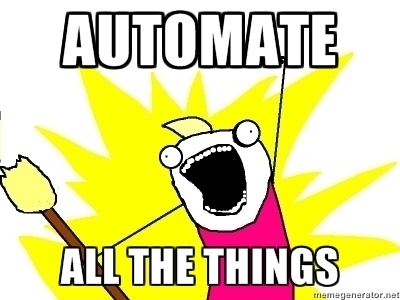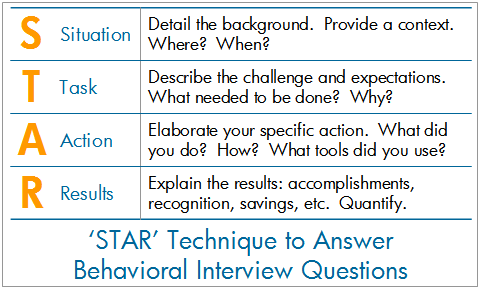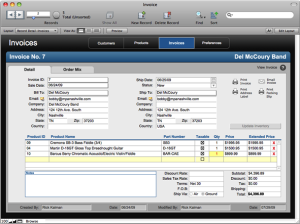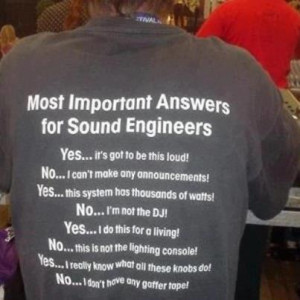Nathan Lively's Blog, page 35
September 27, 2013
Making A Living As A Sound Engineer, Part One: How To Get Paid


 Hello everyone! This is guest writer stevie weenie, coming at you from Prague. I went through audio engineering school with your indestructible host Nathan Lively, who asked me to share some thoughts about making a living as a sound engineer.
Hello everyone! This is guest writer stevie weenie, coming at you from Prague. I went through audio engineering school with your indestructible host Nathan Lively, who asked me to share some thoughts about making a living as a sound engineer.
The most important thing you need to learn about building your career as a sound engineer is how to recognize which situations will lead to money — and which won’t!
PART ONE: HOW TO GET PAIDBE OBSERVANTIDENTIFY SPECIFIC PROBLEMS THAT EXPLAIN BAD SOUNDMost venues with sound problems know that something isn’t right, but they have absolutely no clue what the problem is. By the time they call you they’ve spent a ton of money on expensive fixes that didn’t help. If you can find simple, cheap solutions that make a dramatic improvement in the sound, you get the cookie. You would not believe how often a lovely pro audio system is spoiled by one weak link.
 example 1: surround sound madness
example 1: surround sound madnessProblem: DJ’ing a one-off gig at a new sports bar with a stage for live bands: it is a mess. The IT guy who built the sound system had the right parts but all the wrong connections. The FOH sound goes from a mixing board up on the balcony, DOWN AN UNBALANCED RCA CABLE TO THE BAR, into a surround-sound amp, through a digital processor (adding a 250ms delay to everything), then back to the speakers. The stage monitors are basically a quarter-note out of sync with FOH sound. Bands are physically unable to play their instruments because the FOH sound is so badly delayed.
Solution: Bypass the entire surround sound amp. Send the main L/R mix back through the snake to the stage box, extend XLR cables to a line splitter, and run all six amps in stereo with a mono sub. Install an A/B source switch-box at the amp rack to choose between the bar’s surround receiver-amp and the live mixer sound as inputs.
Result: Regular job as house soundman.
example 2: gain staging from hellProblem: “It always comes out at the wrong volume.” I look in the rack. I see unbalanced Y-adapters plugging two sources into each amp input! They were amplifying an iPod with its volume at 15%, plus a Sky TV system with its volume at 85%, and asking me for a compressor to keep it at the right level. Oh jeez…
Solution: Plug only single balanced connections into the amps. Recognize you are dealing with a human problem, not a technical problem. Tell the bar staff “This big knob with the blue light is for the volume control, you don’t need to touch anything else.”
Result: Flirt with the blonde waitress and go home with money in your pocket.
example 3: surround sound medieval torture chamberProblem: Basement restaurant has four small rooms and one surround sound unit to power them all. Their speaker cables are all pigtail spliced together and rammed into the speaker jacks. They are using the”Back Left” speaker jacks as a stereo pair for the back room! They wonder why it sounds weird.
Solution: Grab the receiver’s model number off the faceplate, download the PDF owner’s manual and look up how the LED display relates to the audio going out to the speaker jacks. Set up the system to run in “all channels stereo,” tighten up the cable splices, and solve their problem. Then I write notes for the bar staff about which button to press on the stereo to get it working again.
Result: They pay your invoice, offer you a free breakfast and call you back again next time they need something. It might not be enough to live on, but this is building your network and in the end, that’s what keeps you alive. Which leads us to the next point:
DON’T BE AN ARROGANT DICKMAKE RECOMMENDATIONS THAT PROVE THAT YOU KNOW WHAT YOU’RE DOINGUsually the boss is fed up with getting ripped off, so he wants somebody who knows what is going on and he doesn’t want any questions. Your job is to fix the problem, then go away. If you start complaining, you become one more person on his list of useless people to fire ASAP. You cannot survive in this business unless you make life easy and pleasant for your clients.
example 1: the soundman vs. “the architects”Problem: An expensive hotel builds a music stage in the bar where there are flat concrete walls, ten-meter ceiling, hardwood floors, GIANT PLATE GLASS WINDOWS PARALLEL TO EACH OTHER. Check out the photos below. The complaint is that the press is giving them reviews of “bad sound”. The owners have been asking their architects to fix the acoustics, the answer comes back 10,000€ for ceiling panels and one custom-stitched thin velvet curtain on the back wall of the stage. You know this will not work.
Solution:
Be professional and don’t laugh at what other people suggested.Suggest simple, cheap, non-destructive solutions that are easily reversible if they change their mind.Put a carpet on stage.Hang some curtains over those plate glass windows.Get some portable acoustic absorber panels on the back wall of the stage.Result: In the end the bosses take your advice because your ideas made sense to them, you removed their fear of permanent damage, and your solutions are thousands of Euros cheaper than what the architects said.


Problem: A club owner spends 2500€ on expensive sound treatment for the room. He goes on to connect a computer, satellite TV, unbalanced mics and a cheap four-channel mixing board through a DJ mixer, all buried under a pile of ashtrays in the DJ booth. He uses booth/zone output jacks from the DJ mixer to control the different rooms in the bar. He doesn’t know why it sounds like crap and wants to buy a subwoofer to fix everything.
Solution: In this case, if you tell the boss he’s an idiot for spending all that money on acoustics, you’re gonna have a problem. What you do is quote him a price that includes the subwoofer and a new mixing board to unite all the sources. Use the new mixer to feed all the amps and run the DJ mixer into it on a stereo channel. Bump the price up enough to include balanced cables on top of your fees, and don’t say peep about the previous mistakes.
 Result: They ask you to train the staff on how to use it, everyone likes it because it’s easier now, and you end up with another working relationship for ongoing tech maintenance.
Result: They ask you to train the staff on how to use it, everyone likes it because it’s easier now, and you end up with another working relationship for ongoing tech maintenance.
(By the way: if you’re in the music business you are either working to sell alcohol or you’re working for drug dealers. The people who think they’re gonna be on a Midas desk for a road touring company with Aerosmith are like saxophone players in music school who say they will never do a wedding.)
FIGURE OUT WHERE THE MONEY COMES FROMGIVE THEM WHAT THEY WANT AND SHUT UPAt every step the question is the same — where does the money come from? From people buying drinks at the bar? Sunday brunch? Fast turnaround for video? A stoner dream of nonsense?
example 1: restaurant dining roomProblem: An expensive bar wants music 18 hours a day. It could be a DJ, playlists, anything; their clientele gravitate toward the atmosphere. Boss uses a battery-powered wireless instrument mic (TS unbalanced) going into the headphone jack of a DJ mixer and over to a receiver at the bar. He complains that it’s too hard to set up and there’s too much bass in the ceiling speakers.
Solution: This one requires some finesse. Dress clean when you go in to talk with them. Seriously! Make a service agreement with your friend who owns a record shop. Your friend books classy DJs, you install a pair of wireless DI boxes with 12V adaptors, and you enjoy a nice working relationship with a posh hip new spot.
Result: The bar manager passes out free slivers of prosciutto, and the people keep buying champagne. Bingo. Your professsional network grows.
example 2: dreamy video soundtrackProblem: Video producer calls and asks, “can you make me a thirty second piece of music for a commercial soundtrack? It should sound energetic and young and jazzy. The budget for the music will pay half your monthly rent. Can you do it by tomorrow?”
Solution: HELL YES! You crank out an eight-bar piano loop with some minor seventh chords and a simple half-funky bassline, drop a beat loop on it from your sample library, hit some reverb, bounce out a stereo mix, and send it the same day for comments. The producer asks for a few easy changes. (THEY NEVER LIKE YOUR FIRST VERSION.)
Result: You make the edits, return it the next morning and get paid. This falls into the category of “nice work if you can get it.”
 example 3: star-struck managers
example 3: star-struck managersProblem: Budweiser books your home venue to shoot a commercial. The boss loves it, he’s taking in two days’ normal income for what will become literally three seconds in a beer commercial. He doesn’t know enough to ask if they plan to use location sound. He doesn’t know anything about lighting, one-day property lease agreements, or any of the stuff their crew expects to see in a normal day. Budweiser comes in with a generator truck, a million watts of lighting, catering, a pile of extras and a pro film crew.
Solution: You spend the day climbing your truss to turn off the moving gobo lights because their soundman can hear the fans. You silence phone ringers, printers, espresso machine steam hiss, and ice machine internal avalanches. You crawl around under the bar to turn off the refrigerators because they buzz. You turn off the fire alarm and illegally bypass it because their lighting rig sets it off every five minutes. You smile at the extras and get dissed at the catering truck; you even find a color printer for the director’s PDF of the script for his next project.
Result: In the end, you prevent catastrophic failure and get ignored by the honchos. One peon thanks you for saving his ass — it’s the location scout. Anyway, you charge your boss triple your normal day rate and go turn all the refrigerators back on.
CONCLUSION: Please be mentally smart inside your brains and notice that in nearly every example, the goal you are going for is not quick cash, it is to grow your network. Success depends on people; this is so obvious that most people miss it. After the first few years, most of your new business comes from your network, by recommendations and personal contacts. When you solve problems for other people, you get paid, and that’s the last word.
Sign up now to receive the thrilling conclusion of Steve Smith’s Making A Living As A Sound Engineer, Part Two: How NOT To Get PaidI respect your privacy. I will never share your email address with anyone, period.
The post Making A Living As A Sound Engineer, Part One: How To Get Paid appeared first on Sound Design Live.
September 22, 2013
Sound Design Live Podcast Greatest Hits Volume 1

 This is a MEGA SHOW!
This is a MEGA SHOW!For this episode of the Sound Design Live podcast, I compiled a full hour of the best clips from my first two years of interviews, some of which are also included in my new eBook Sound Design Live: Build Your Career As A Sound Engineer. You’ll hear all about about online dating, AVB, how to move up in theatre, how to integrate live streaming into your live event, why Mix Magazine sucks, the dying art of theatrical acting, the pros/cons of gigging with a laptop, working in the West End, how to do an ABX blind test, creativity in pro audio, and why being a sound engineer is amazing.

Struggling with gigging, and becoming so intimate with artists and their musical dreams, gives me an opportunity to be a better person.
Dimitris Sotiropoulos
Details from the podcast:
All music in this episode by Zé Dos Frangos, The Riot Professor, and Mark WinslettThe new eBook: Sound Design Live: Build Your Career As A Sound Engineer Mark Winslett’s GoFundMe page Clips in this compilation are from:Cables Are Dead with Ellen JuhlinFrom Highschool Dropout to Head Of Audio with Steve BrownFrom Free To Fee with Eddie CodelLarry Crane & Tape Op MagazineHow To Mic An 800-Seat Theatre With Floor Mics with Pierre DupreeLaptops Do Not Make Live Sound Simpler with Howie GordonDesigning Without a Script with Andy GrahamShow Networks and Control Systems with John HuntingtonBuild A $100,000 Mixing Board with Bob LentiniHow To Use Plugins With An Analog Console and Wireless Control with Dimitris SotiropoulosMixing For Emmylou Harris & Producing SXSW with Roy Taylor
The post Sound Design Live Podcast Greatest Hits Volume 1 appeared first on Sound Design Live.
September 13, 2013
Making A Living As A Sound Engineer, Part One: How To Get Paid
Hello everyone! This is guest writer stevie weenie, coming at you from Prague. I went through audio engineering school with your indestructible host Nathan Lively, who asked me to share some thoughts about making a living as a sound engineer.
The most important thing you need to learn about building your career as a sound engineer is how to recognize which situations will lead to money — and which won’t!
PART ONE: HOW TO GET PAID
BE OBSERVANT
IDENTIFY SPECIFIC PROBLEMS THAT EXPLAIN BAD SOUND
Most venues with sound problems know that something isn’t right, but they have absolutely no clue what the problem is. By the time they call you they’ve spent a ton of money on expensive fixes that didn’t help. If you can find simple, cheap solutions that make a dramatic improvement in the sound, you get the cookie. You would not believe how often a lovely pro audio system is spoiled by one weak link.
example 1: surround sound madness
Problem: DJ’ing a one-off gig at a new sports bar with a stage for live bands: it is a mess. The IT guy who built the sound system had the right parts but all the wrong connections. The FOH sound goes from a mixing board up on the balcony, DOWN AN UNBALANCED RCA CABLE TO THE BAR, into a surround-sound amp, through a digital processor (adding a 250ms delay to everything), then back to the speakers. The stage monitors are basically a quarter-note out of sync with FOH sound. Bands are physically unable to play their instruments because the FOH sound is so badly delayed.
Solution: Bypass the entire surround sound amp. Send the main L/R mix back through the snake to the stage box, extend XLR cables to a line splitter, and run all six amps in stereo with a mono sub. Install an A/B source switch-box at the amp rack to choose between the bar’s surround receiver-amp and the live mixer sound as inputs.
Result: Regular job as house soundman.
example 2: gain staging from hell
Problem: “It always comes out at the wrong volume.” I look in the rack. I see unbalanced Y-adapters plugging two sources into each amp input! They were amplifying an iPod with its volume at 15%, plus a Sky TV system with its volume at 85%, and asking me for a compressor to keep it at the right level. Oh jeez…
Solution: Plug only single balanced connections into the amps. Recognize you are dealing with a human problem, not a technical problem. Tell the bar staff “This big knob with the blue light is for the volume control, you don’t need to touch anything else.”
Result: Flirt with the blonde waitress and go home with money in your pocket.
example 3: surround sound medieval torture chamber
Problem: Basement restaurant has four small rooms and one surround sound unit to power them all. Their speaker cables are all pigtail spliced together and rammed into the speaker jacks. They are using the”Back Left” speaker jacks as a stereo pair for the back room! They wonder why it sounds weird.
Solution: Grab the receiver’s model number off the faceplate, download the PDF owner’s manual and look up how the LED display relates to the audio going out to the speaker jacks. Set up the system to run in “all channels stereo,” tighten up the cable splices, and solve their problem. Then I write notes for the bar staff about which button to press on the stereo to get it working again.
Result: They pay your invoice, offer you a free breakfast and call you back again next time they need something. It might not be enough to live on, but this is building your network and in the end, that’s what keeps you alive. Which leads us to the next point:
DON’T BE AN ARROGANT DICK
MAKE RECOMMENDATIONS THAT PROVE THAT YOU KNOW WHAT YOU’RE DOING
Usually the boss is fed up with getting ripped off, so he wants somebody who knows what is going on and he doesn’t want any questions. Your job is to fix the problem, then go away. If you start complaining, you become one more person on his list of useless people to fire ASAP. You cannot survive in this business unless you make life easy and pleasant for your clients.
example 1: the soundman vs. “the architects”
Problem: An expensive hotel builds a music stage in the bar where there are flat concrete walls, ten-meter ceiling, hardwood floors, GIANT PLATE GLASS WINDOWS PARALLEL TO EACH OTHER. Check out the photos below. The complaint is that the press is giving them reviews of “bad sound”. The owners have been asking their architects to fix the acoustics, the answer comes back 10,000€ for ceiling panels and one custom-stitched thin velvet curtain on the back wall of the stage. You know this will not work.
Solution:
Be professional and don’t laugh at what other people suggested.
Suggest simple, cheap, non-destructive solutions that are easily reversible if they change their mind.
Put a carpet on stage.
Hang some curtains over those plate glass windows.
Get some portable acoustic absorber panels on the back wall of the stage.
Result: In the end the bosses take your advice because your ideas made sense to them, you removed their fear of permanent damage, and your solutions are thousands of Euros cheaper than what the architects said.


example 2: overworked restaurant owner
Problem: A club owner spends 2500€ on expensive sound treatment for the room. He goes on to connect a computer, satellite TV, unbalanced mics and a cheap four-channel mixing board through a DJ mixer, all buried under a pile of ashtrays in the DJ booth. He uses booth/zone output jacks from the DJ mixer to control the different rooms in the bar. He doesn’t know why it sounds like crap and wants to buy a subwoofer to fix everything.
Solution: In this case, if you tell the boss he’s an idiot for spending all that money on acoustics, you’re gonna have a problem. What you do is quote him a price that includes the subwoofer and a new mixing board to unite all the sources. Use the new mixer to feed all the amps and run the DJ mixer into it on a stereo channel. Bump the price up enough to include balanced cables on top of your fees, and don’t say peep about the previous mistakes.
 Result: They ask you to train the staff on how to use it, everyone likes it because it’s easier now, and you end up with another working relationship for ongoing tech maintenance.
Result: They ask you to train the staff on how to use it, everyone likes it because it’s easier now, and you end up with another working relationship for ongoing tech maintenance.
(By the way: if you’re in the music business you are either working to sell alcohol or you’re working for drug dealers. The people who think they’re gonna be on a Midas desk for a road touring company with Aerosmith are like saxophone players in music school who say they will never do a wedding.)
FIGURE OUT WHERE THE MONEY COMES FROM
GIVE THEM WHAT THEY WANT AND SHUT UP
At every step the question is the same — where does the money come from? From people buying drinks at the bar? Sunday brunch? Fast turnaround for video? A stoner dream of nonsense?
example 1: restaurant dining room
Problem: An expensive bar wants music 18 hours a day. It could be a DJ, playlists, anything; their clientele gravitate toward the atmosphere. Boss uses a battery-powered wireless instrument mic (TS unbalanced) going into the headphone jack of a DJ mixer and over to a receiver at the bar. He complains that it’s too hard to set up and there’s too much bass in the ceiling speakers.
Solution: This one requires some finesse. Dress clean when you go in to talk with them. Seriously! Make a service agreement with your friend who owns a record shop. Your friend books classy DJs, you install a pair of wireless DI boxes with 12V adaptors, and you enjoy a nice working relationship with a posh hip new spot.
Result: The bar manager passes out free slivers of prosciutto, and the people keep buying champagne. Bingo. Your professsional network grows.
example 2: dreamy video soundtrack
Problem: Video producer calls and asks, “can you make me a thirty second piece of music for a commercial soundtrack? It should sound energetic and young and jazzy. The budget for the music will pay half your monthly rent. Can you do it by tomorrow?”
Solution: HELL YES! You crank out an eight-bar piano loop with some minor seventh chords and a simple half-funky bassline, drop a beat loop on it from your sample library, hit some reverb, bounce out a stereo mix, and send it the same day for comments. The producer asks for a few easy changes. (THEY NEVER LIKE YOUR FIRST VERSION.)
Result: You make the edits, return it the next morning and get paid. This falls into the category of “nice work if you can get it.”
example 3: star-struck managers
Problem: Budweiser books your home venue to shoot a commercial. The boss loves it, he’s taking in two days’ normal income for what will become literally three seconds in a beer commercial. He doesn’t know enough to ask if they plan to use location sound. He doesn’t know anything about lighting, one-day property lease agreements, or any of the stuff their crew expects to see in a normal day. Budweiser comes in with a generator truck, a million watts of lighting, catering, a pile of extras and a pro film crew.
Solution: You spend the day climbing your truss to turn off the moving gobo lights because their soundman can hear the fans. You silence phone ringers, printers, espresso machine steam hiss, and ice machine internal avalanches. You crawl around under the bar to turn off the refrigerators because they buzz. You turn off the fire alarm and illegally bypass it because their lighting rig sets it off every five minutes. You smile at the extras and get dissed at the catering truck; you even find a color printer for the director’s PDF of the script for his next project.
Result: In the end, you prevent catastrophic failure and get ignored by the honchos. One peon thanks you for saving his ass — it’s the location scout. Anyway, you charge your boss triple your normal day rate and go turn all the refrigerators back on.
CONCLUSION: Please be mentally smart inside your brains and notice that in nearly every example, the goal you are going for is not quick cash, it is to grow your network. Success depends on people; this is so obvious that most people miss it. After the first few years, most of your new business comes from your network, by recommendations and personal contacts. When you solve problems for other people, you get paid, and that’s the last word.
Sign up now to receive the thrilling conclusion of Steve Smith’s Making A Living As A Sound Engineer, Part Two: How NOT To Get Paid
I respect your privacy. I will never share your email address with anyone, period.
Steve Smith is musician, artist, and sound engineer living in Prague, Czech Republic. Check out his music.
The post Making A Living As A Sound Engineer, Part One: How To Get Paid appeared first on Sound Design Live.
September 8, 2013
How Much Do Live Sound Engineers Make?


So, how much money do live sound engineers make?
As you can imagine, there is no one-size-fits-all answer to this question. Instead, I’d like to show you a few profiles that represent a cross-section of the industry. Keep in mind that the numbers included below are very specific to one location and person.

PROFILE 1: San Francisco Bay Area
Nathan Lively – Sound Engineer/Designer (That’s me!)
Presently I split my time like this: 30% concert, 30% corporate, 30% working on Sound Design Live (that’s this site!). For most jobs, I’m paid as follows:
$20-25/hour working as an A1 or A2 on concerts.
$25-32/hour working on corporate events. These are mostly subcontracting situations where I receive a percentage of the total labor charges.
$50/hour working with my own clients and bringing in my own equipment. These jobs only happen a few times a year. Last year I produced a corporate webcast event for almost $100/hour. Great, I know, and I’m trying to get more of that work!
$0/hour working on Sound Design Live. Help support it by buying a book or donating!
A couple of years ago I worked mostly as a sound designer and contracts ranged from $500 to $2,500. It was fun and could potentially have resulted in more money, but it was hard to put together a workable schedule. Rehearsals and meetings would conflict and I would have months of down time. Before that I toured, which earned me $550/week ($2,200/month) but was emotionally taxing.
In Slovakia I made €75/day ($100) subcontracting. In Portugal I earned €150/day ($188) working with my own clients. The first sound engineering job I ever had in Portugal paid €35/day ($44), and I was just happy to be able to stay in the country. After that first show I went to the bar down the street that was so small that you could only squeeze in, order your drink, and walk back into the street. I spent half my money on two caipirinhas and felt great.

PROFILE 2: Prague (Czech Republic)
Steve Smith – Sound Engineer & Musician
Prague rates look like this:
50€ to do live sound for one concert in a small club using their gear.
75€ to be soundman for one night at a club with two stages, two bands, and one DJ crew.
250€ to do sound for a show where you bring mics and an FX rack.
200-400€ for a wedding gig where you bring the sound system and DJ.
50€ per musician for a band.
Stay tuned for a more in-depth look at Steve’s experience working in Prague next week.

PROFILE 3: Bratislava (Slovakia)
Michal – Sound Engineer & Musician
60€ as a helper for local gigs, but €100 for a corporate party.
700€/month as a broadcast sound engineer (rate has held steady for the past 15 years).
100€ for composing and recording 72 different sounds for an iPad app.
I also do technical support for the most famous band in our country. For one gig I get 180€, but it takes three days of my life: one day to pick up all of the equipment, one day for the gig, and one day to return it all.

PROFILE 4: Athens (Greece)
Dimitris Sotiropoulos – Sound Engineer/Designer
The live work I take offers anywhere from 100€ το 400€ depending on how large the “pie” is to cut. For the past three summers I have been doing monitors for a well known Greek duo, which pays 300€/event at the moment. Most live gigs during the winter take place in bars or small cafes, which involves more work setting up, running cables, and doing both FOH and Monitors for 3-4 people. Negotiated fees can range anywhere from 100-250€/event.
I try to take any audio related project at present, since we’ve been in free fall — the economy that is — these past years. Here are some examples of summer projects and their negotiated fees:
1,500€ for renting out some of my studio equipment to set up a remote recording location in a country house for an album’s pre-production sessions.
150€/day to rewire a studio, which reminded me how challenging it can be to get the normaling right on the patchbays, keeping cable lengths to a minimum, and satisfying my OCD with regard to having everything as neat as possible. It took me ten days to get it up and running to minimum prerequisites; then again, it was only me and a soldering iron. Need a week or so to wrap it up with no more downtime.
600€ for a sound design project for a cosmetics company’s social media video campaign.
350€/day (negotiated) as a backup recording engineer at a three-day festival in Athens (suntan lotion was not provided).
300€ plus expenses for the following: organizing and assembling a complex stage plot and rider for a concert on an island in the Ionian Sea, with limited resources other than those packed and shipped on time by the rental company; programming four shows for both Avid Venue Consoles (FOH-Monitors) for the two acts that night on the boat trip there and the night before into the early morning; and recording the first act via direct outs from the monitors console to my HD Rig (32ch). A nightmare of timing and organization.
1,500€ for booking a lockout recording session next month for a week.
I’ll have more about Dimitris’ experience next week.
Want to add your financial information to the mix? Contact me or comment below.
The post How Much Do Live Sound Engineers Make? appeared first on Sound Design Live.
September 1, 2013
The Best Search Engines For Sound Engineer Jobs


 In the last post I showed you how to automate your job search. Unfortunately, the best search engines for sound engineer jobs do not allow this; either they are behind paid gateways or they don’t play well with RSS. Let’s take a closer look at those sites now.
In the last post I showed you how to automate your job search. Unfortunately, the best search engines for sound engineer jobs do not allow this; either they are behind paid gateways or they don’t play well with RSS. Let’s take a closer look at those sites now.
I’ve been on the job hunt for over ten years – one of the perks of being an independent contractor who moves a lot. I’ve only ever landed two jobs from search engines, but they were a great national tour and a super fun play. So even though search engines only got me two gigs, but I still use them, for three reasons: 1) the chance that something will come up that I really want; 2) to make contacts; and 3) to share jobs with people like you! (Speaking of which, you should probably follow me on twitter.) I might not get hired for a particular job, but each post can be a great opening to meet the people producers and managers who will no doubt be hiring again in the future.
Artsearch
Paid ($40 for six months, $60 for a year)
Pros: All of the listings are real jobs in theatre; no internships or bar gigs. It seems to be well curated. Right now I see eight audio-related jobs listed across the U: six full-time, one part-time, and one seasonal. This site is how I landed a national theatrical tour.
Cons: Most listings are for the eastern half of the US & Canada, so the rest of us should be prepared to travel.
(While I don’t suggest abusing their excellent service, a birdie just told me that if you Google “artsearch login,” you might be able to get in for free. Seems like lots of schools and groups share their login info locally, possibly not realizing that it is public. Whoops!)
Off Stage Jobs
Free
Pros: This site is run by a lighting designer, Patrick Hudson, so it’s just for people like us. Mostly theatre, but there are some concert jobs as well.
Cons: The site has one major problem: I can never stay logged in! Every time I submit a query, I get logged out. I have been back and forth with Hudson on this, and we can’t figure it out. Hopefully you won’t have the same problem. If you do, you can can still search the job listings, but you’ll have to log in again to see the contact info.
Local Listings
Depends
There are other national job databases, but most are not very good for finding sound engineer jobs. Your next best bet is your local theatre arts community website. In the bay area you can pay $70 to become a member of Theatre Bay Area and search their listings for a year. This is how I got my first sound design gig in San Francisco with Boxcar Theatre.
In Austin I used Austin Actors. Look under Cast and Crew Calls.
Have more local sites to share? Comment below!
Other
Depends
You might also try Music Jobs ($10/month) for concert, PLASA and InfoComm for AV install, USITT for theatre, AACT for community theatre, Blue Room for backstage jobs in the UK, Playbill for theatre in NYC, and Cirque du Soleil. I’ve applied for jobs through several of these sites without much luck. Let me know how it goes for you.
To Sum Up
Artsearch and Off Stage Jobs are your best bets for concert and theatre jobs for sound engineers and sound designers.
Local listings in your city are the next best option. Often there are crew calls in the local theatre arts community sites.
There are lots of other industry and show specific sites that you should have on your radar, but they are hit and miss.
The post The Best Search Engines For Sound Engineer Jobs appeared first on Sound Design Live.
August 25, 2013
How To Automate Your Job Search


 This is my super easy guide to automate your search for sound engineer jobs (and sound designer, AV tech, etc.). What’s the trick? Craigslist. Local contract labor isn’t often listed on the national job search sites like ArtSearch and SimplyHired (which I plan to review in the next post), and even when work is posted on one of the bigger sites, it is often double posted on Craigslist. All you have to do is create an RSS feed from your Craigslist search, like so:
This is my super easy guide to automate your search for sound engineer jobs (and sound designer, AV tech, etc.). What’s the trick? Craigslist. Local contract labor isn’t often listed on the national job search sites like ArtSearch and SimplyHired (which I plan to review in the next post), and even when work is posted on one of the bigger sites, it is often double posted on Craigslist. All you have to do is create an RSS feed from your Craigslist search, like so:
Step 1 : Search For Sound Engineer Jobs
If you live in in the Bay Area like I do, you can search 9 counties (with 400 theatre companies!) all at once from http://sfbay.craigslist.org. But what if you want to search for sound engineer, audio engineer, audio technician, AV tech, and sound designer posts in every city within 50 miles? Time to setup that RSS feed. It’s easy, just make a list of all search terms and locations you would like to use, then input them one at a time, each in a new browser tab.
It takes a little while, and there are some sites like Search Tempest and TinkOMatic that automate this task, but I’ve seen sites like this go under and get boxed out by Craigslist, so I think the most reliable solution is to do the searches one-by-one directly from Craigslist. Don’t worry. You’ll only have to do this once.
If you are getting too many results with every query, try restricting the search. These will go directly into your RSS reader, so you don’t want 100 of them every day. Try searching job titles only and restricting it to contract and part-time work.
Step 2: Add To Your RSS Reader
Google Reader is dead, long live Google Reader. I use Feedly. It has a nice interface and is easy to use. Create a category called Job Listings. Go back to your job search tabs and at the bottom-right of the page you will see an RSS link; save that link. In Feedly, click on Add Content, paste the link, and add it to your Job Listings category.
That’s it! Every day you’ll get fresh results without running all over the interwebs.
Bonus: Add Indeed and Simply Hired
I’ve noticed that Indeed and SimplyHired sometimes have pro audio jobs, so it might be worthwhile to add those to your feed reader but you will likely get some duplicates. Neither have a nice RSS link like Craigslist, but guess what, you can submit a search on Indeed then copy the URL and paste it into Feedly. Easy.
Have any good tips to add for automating your sound engineer job search? Comment below!
The post How To Automate Your Job Search appeared first on Sound Design Live.
August 18, 2013
Interview Tips: the S.T.A.R. Technique



In the last post, Paul Griffiths gave us some great tips for successful job searches and interviews. Let’s take a closer look at one technique he mentioned– the S.T.A.R. technique – using examples from his original post. Every question that an interviewer asks you is an attempt to find out whether your experience matches the job requirements. S.T.A.R. gives you a framework to answer those questions in a logical manner, so you can effectively share your work experience.
S.T.A.R. = Situation Task Action Result
Step 1 – Situation or Task

Describe the situation that you were confronted with or the task that needed to be accomplished. With the S.T.A.R. approach, you need to set the context. Make it concise and informative, concentrating solely on what is useful to the story.
Paul Griffiths
I don’t have a very good memory, so when I prepare for a job interview I make a table listing each job requirement. Then I write two examples of competency for each specific requirement. For example, when a job requires working with RF systems, I like to talk about the 40+ channel system I worked with at the National Theatre of Portugal. When a job requires specific pieces of software or hardware that I don’t have recent or firsthand experience with, I list two similar products. For example, I don’t use Protools regularly anymore, but using Logic Pro exercises my multi-track recording skills, which are easily transferable to other software.
After I’ve filled out the table and studied it, I like to get a friend to test me, because I won’t have the table with me at the interview when I need to respond quickly and with confidence. Mostly, having this knowledge at your fingertips will make you more confident in your skills. You may think you are completely qualified, but as Griffiths said in our interview, “It isn’t always the best candidate who gets the job; it’s the best prepared candidate that gets the job. You need to convince them that you’re the best candidate for that job. If you don’t, you’ll never get anywhere.”
Step 2 – Action

You need to demonstrate and highlight the skills and personal attributes that the question is testing. Now that you have set the context of your story, you need to explain what you did.
Paul Griffiths
Basically, you need a bunch of stories to show how kick-ass you are and how you save the day on the regular. Remember, story quality is more important appropriateness, so make sure it’s a good one. When I talk about my work experience in Slovakia, I like to say: “I learned how to calculate total wattage, how to mic an orchestra, and how to eat sausage and schnapps for EVERY meal.” Use the table I mentioned before to note a great story you can tell for each of the job requirements.
Another good interview tip: prepare a story for the most common interview questions:
Why do you want to work here?
Are you good at working under pressure?
Are you a good problem solver?
What is your greatest weakness?
Step 3 – Result

Use the opportunity to describe what you accomplished and what you learned in that situation. This helps you make the answer personal and enables you to highlight further skills.
Paul Griffiths
Put simply: wrap it up. Tell how your context and stories pack neatly in package with a shiny bow on top. For example, concerning RF systems I would say I’ve used them at three different professional venues that I listed on my application, and have learned a host of troubleshooting techniques like the one I used to save the day. I also improve my knowledge on my own time by participating in the Theatre Sound forum online and attending pro audio seminars.
To Sum Up
Create a table with the job requirements and connect them with examples of your work experience and great stories.
Practice answering review questions in a logical manner by citing a Situation or Task, the Action you took, and the Result.
Be engaging. Be memorable. Don’t forget to smile!
BONUS
Speaking of confidence, before the interview, watch this video.
The post Interview Tips: the S.T.A.R. Technique appeared first on Sound Design Live.
August 11, 2013
Beyond FOH: Job Search Advice For Sound Engineers


In this episode of Sound Design Live, I speak with pro audio recruitment consultant and talent acquisition manager Paul Griffiths about job search and how to prepare for interviews. We also discuss lateral movement within the field of pro audio − for example, how a sound engineer or musician might transfer their technical and customer service experience into a tech support position or a sound designer could turn their experience into a project manager position.
I was really excited to do this interview, because I think as sound engineers we get trapped by the rock-star myth and end up working mostly at clubs and concert venues. The truth is that there are many opportunities beyond FOH for people like us who have experience in professional audio and live events.

It isn’t always the best candidate who gets the job; the best prepared candidate that gets the job. You need to convince them that you’re the best candidate for that job. If you don’t, you’ll never get anywhere.
Paul Griffiths
Podcast Details:
All music in this episode by The Riot Professor
Griffiths works at Wilson Orange
Blog
Job Listings
Send your resume
PLASA = Professional Lighting And Sound Association
S.T.A.R. = Situation, Task, Action, Result
Allen & Heath, Midas
“Choose a job you love, and you will never have to work a day in your life.” -Confucius
Tweets by @WilsonOrange
The post Beyond FOH: Job Search Advice For Sound Engineers appeared first on Sound Design Live.
August 4, 2013
Easy Invoicing For Sound Engineers


 In the last two posts we talked a lot about career advice and how to always be professional. Don’t worry, I’m not going to rant about email this time — I’m going to rant about invoicing instead!
In the last two posts we talked a lot about career advice and how to always be professional. Don’t worry, I’m not going to rant about email this time — I’m going to rant about invoicing instead!
As an independent contractor, you will invoice many of your clients. If you work semi-regularly at an event venue you may be asked to submit a W-9, but you can still request to take care of your own invoicing, thereby avoiding automatic tax withholding by the client. Whether or not this route is right for you is another discussion, but I will say this: your income will always be taxed, and it can be nice to have someone else take care of that. The rest of the time, you’ll need invoices.
In this article I use Filemaker Pro ($300) as an example, but the process will be similar with most database software. You can create your invoices in Word, or type them straight into an email, or even scribble them in pencil on a napkin, but using a database allows for excellent record keeping and looks more pro.
Getting Started
 I’ve been using Filemaker Pro for three years. It comes with a nice selection of templates that require very little tweaking. As pro audio freelancers we don’t have a million line items or shipping to worry about, so our needs are minimal. The invoicing template in Filemaker basically connects three databases: Customers, Products, and Invoices. I started from scratch, so I manually entered each new contact per invoice, but there are methods provided for importing contacts from other sources.
I’ve been using Filemaker Pro for three years. It comes with a nice selection of templates that require very little tweaking. As pro audio freelancers we don’t have a million line items or shipping to worry about, so our needs are minimal. The invoicing template in Filemaker basically connects three databases: Customers, Products, and Invoices. I started from scratch, so I manually entered each new contact per invoice, but there are methods provided for importing contacts from other sources.
The products database contains your list of services and equipment rentals. The taxonomy that I use for services is [client name] [service date] [event title] [event code]. For example, one of the last events that I worked was “MagicSound 08/04/13 AmazingBand CO:12345″. Sometimes companies will have an internal code for the event that you should reference on the invoice. I don’t have a lot of rental equipment so I use general descriptions like MacBook Pro and Software Mix System. How much should you rent your personal equipment for? It varies 2-15%. Really. Projectors are expensive to rent because they require regular maintenance and have limited bulb life. On the other hand, cable covers and similar low-upkeep hardware should be cheaper. I often rent my computer or software mix system out cheap to eliminate one more unfamiliar variable from the sound system.
Completing the invoice is pretty straightforward once you have your client information and products. Sometimes I’ll add a discount when I’m renting out my own equipment for multiple days, like when I was on tour. What are terms? This is where you get to set the maximum number of days allowed for payment, and where you may include a discount for early payment or an interest charge for late payments. Generally, it’s best to get paid as fast as possible. Corporate event producers who are really on top of their game will try to pay me before the event just to get it taken care of. Those are rare, though. Most of the time people will deal with your invoice after money for the event has come in, or at the end of the month when they pay everyone else. I use a standard term of fifteen days, and I’ve never charged interest for late payments.
Changing The Print Layout
One of the first things that you’ll want to do to make your invoices look less generic is to modify the print layout. First, streamline it by removing empty fields; most of us don’t need things like Sales Tax and Shipping Address, so get ‘em out of there. Include your payment options at the top. Here’s what my print layout looks like:
I use a big Notes section at the bottom to accommodate a variety of information that doesn’t fit a specific field. If you make mistakes and can’t figure out how to get back, just reload the same template and start over.
Next, add your own logo so it looks pro. What if you don’t have a logo? Go to your header and change the font for your name and/or your business name to something more interesting than twelve-point Times New Roman.
Filemaker Pro includes a link to email the invoice; some of my clients have been unable to open these attachments. The best method for universal access is to click Print Invoice, then Save as PDF from the print options screen.
Synchronizing
My Filemaker Pro invoices document is saved to Dropbox, which updates on all of my devices. The only problem was that I couldn’t open those files on any device other than a computer, until now! Filemaker Pro finally has an iPhone app. I can use my iPhone to access the database file in Dropbox then send it to Filemaker Go. If I make any changes, I have to send it back to Dropbox, which breaks my elegant synchronizing system, but for the most part I need to access the database to find client information or read invoices, not to make changes.
You’ll notice that every new invoice is automatically numbered. I’ve encountered problems when submitting a revised invoice: the client sees the same invoice number and is confused. There may be a way to add a modifier to the invoice number, but I work around the problem by changing the invoice date and adding a note about what changes were made. I might even change the invoice number in the exported PDF file name, turning 101 into 101a, for example
To Sum Up
Find good database software for invoicing like Filemaker Pro.
Input client and product information (remember to use an easy taxonomy since you’ll end up with hundreds of “products” after a few years of billing for events).
Format the print layout to be as simple and professional as possible.
Make sure the invoice database file is available on all your devices, and syncs automatically.
Is there an easier way? What invoicing software are you using?
The post Easy Invoicing For Sound Engineers appeared first on Sound Design Live.
July 28, 2013
Best Tips For Building A Career In Pro Audio


In my interview with Harry Mack, he gave us a lot of great tips for building a career as a freelance designer. I originally contacted Harry because of the article he wrote for Gamasutra called Best Tips for Building a Freelance Career. I’d like to combine the valuable advice from those sources and apply it to a career in pro audio as a sound engineer or designer.
Always Be Professional

Use correct grammar and spelling in emails, with no shorthand. Speak clearly, confidently, and to the point. Be friendly and courteous. Respond promptly to emails. Be available. This is straightforward stuff, but being consistently professional will set you head and shoulders above the rest of the competition.
Harry Mack
This sounds easy, but is so hard. Sure, the first few months that you live in a new city you are checking your email every few minutes and bend over backwards to serve every potential client. But over time you become more and more busy, and it becomes harder to answer every email on time, friendly, and courteously. But damn, it’s so important! I know firsthand because I love it when people email me back promptly. That feels like a real relationship. When people email me back a month later without answering my questions, it feels like no relationship. I don’t have such a hard time calling people back, but it’s difficult for me to make email a priority.
 Since I’ve just identified email as the biggest hassle in my professional life, let’s solve it! Where to start? (Please say productivity tools please say productivity tools please say productivity tools.) No! No more games! Let’s get down to business.
Since I’ve just identified email as the biggest hassle in my professional life, let’s solve it! Where to start? (Please say productivity tools please say productivity tools please say productivity tools.) No! No more games! Let’s get down to business.
Set a timer for 30 minutes.
Organize your inbox: I must go through messages in a chronological order; there is just no other acceptable way for my mind to work. That’s fine, but it means I won’t respond to every message.
Response Time < 30sec: Respond, move to SAVE folder.
Response Time > 30sec: File under ACTION.
Response Time > 30sec + Urgent: Flag Red, move to ACTION.
Response Time > 10min: Just pick up the damn phone.
If I reach the time limit and haven’t responded to all red flags, schedule a follow-up time, rinse and repeat.
When Inbox is empty, move to ACTION folder and follow the same steps.
Okay, let’s try this out. If I force myself to go through my inbox and not follow any links out, I file all of today’s email in ten minutes, complete flagged items in fifteen minutes, and have five minutes left to look at one ACTION item. Once I have momentum, it’s easy to prioritize and stay focused. I know the ACTION folder will build up, so I’ll have to schedule extra time to look at that once a week. In my particular case I have thousands of inbox emails going back five years. The only solution I’ve heard for this problem is called email amnesty and it works like this: 1) Select all; 2) Delete. Then email all of your contacts and let them know that if they sent you anything important in the last five years, please send it again. If you sent me that, I would be a little annoyed, but totally sympathetic.
After going through your inbox a few times for organization, you will start to notice email newsletters and other regular mailings that you never read. Unsubscribe or add filters so that they automatically get filed away and don’t waste your time.
As an aside, I would love an app that reads my email to me and then takes dictation. If anyone knows of something like that, or wants to build it with me, comment below!
The Bidding Process
I’ve found the most successful tactic is to present a bid with a best-case and worst-case scenario. They’ll likely have a number in their head before contacting you, so if you overbid you’ll lose before even starting, and if you underbid, and underbid consistently, well, that’s a hard life to lead.
Harry Mack
My father once told me, “You don’t want to be known as the cheap guy who does great work.” One of the best things that I’ve learned from reading Ramit Sethi, talking to Harry Mack, and going to the dentist, is to never compete on price. When the customer asks about price, steer them back to focus on the content of the project. Talking about money too early on does a disservice to you and the client for two reasons: 1) You can’t give a meaningful quote without the right information, and 2) You want to be remembered for quality work, not low price, so even if they don’t end up working with you they should remember your personality and insightful conversation.
Another advantage of using the best-case/worst-case bid is demonstrating to the client that I am aware of their budget concerns. Make sure you research the client when quoting, though, because a bare-bones estimate for an international law firm is a lot different than one for a local college.
Managing Multiple Projects
Working freelance has its ups and downs. Sometimes I’ll be up to my ears fighting off multiple projects at once, and it can be tricky making sure I get everything organized. Planning is important here, because the goal is to make sure every client gets the correct audio before milestones, without forgetting anything.
Harry Mack
For my sound engineering work, this is a little more simple to manage. I just make sure that I have my calendars synced between web, computer, and phone, and immediately add information I receive about the event load-in, start/end time, contacts, special requirements, and other details. For my sound design work I put milestones into the calendar to make sure I am on schedule to have all assets ready on time. Also, I use the Notes app in OSX and iOS to keep information synced across devices.
Like other sound engineers, I work with several clients regularly who need to know my availability. One technique that I’ve employed that I know some of you out there also use is to publish my work calendar publicly on my website. That way, when a client has an event they want me to work, they can quickly see whether or not I’m available.
Criticism is a Good Thing
I’ve been told that one of my best traits as an audio designer is that I take criticism in a friendly and professional manner. It took a while to get there, as I’ve always been defensive of things I put time and thought into. Who isn’t? “The customer is always right” is a phrase everyone knows for a reason: it’s true. They are funding and making the game, and likely have a vision for the end product, including how it’s going to sound.
Harry Mack
 OMG OMG OMG. This is so hard. Easy to talk about, difficult to practice. Just like Harry, I’ve had people tell me that they really like working with me because I’m easygoing and have a very can-do attitude. The reason I started working with the best band in Portugal is that I was the first one to ever let them try group distance miking. But the truth is that the ego is easily offended and can cause painful emotional surprises.
OMG OMG OMG. This is so hard. Easy to talk about, difficult to practice. Just like Harry, I’ve had people tell me that they really like working with me because I’m easygoing and have a very can-do attitude. The reason I started working with the best band in Portugal is that I was the first one to ever let them try group distance miking. But the truth is that the ego is easily offended and can cause painful emotional surprises.
There are lots of little communication techniques that you learn over years of working on events to avoid these surprises. Most sound engineers know this one: when an audience member comes to make a suggestion, just say, “Okay, sure!” then lean over and pretend to make changes, instead of engaging them. One of my favorite techniques that I came upon in the last year is checking in with the client regularly. It sounds so obvious, but I used to be the kind of guy that would walk in, avoid eye contact, evade conversation, and then at the very end say, “Ta-da! You like?”
Client: “The piano is on the wrong side of the stage. Can you move it?”
Me: “Why didn’t you say something? Now there are a million mics and chairs setup around it.”
A common example is corporate event producers who don’t want to see microphones or speakers, so they ask for lapel mics. The first thing I do is set up a quick demo so that they can hear sound quality and perceived loudness compared to a wireless handheld microphone. Then we usually have a quick conversation about acoustics and physics, yay!

It’s a goddamn service industry.
Larry Crane
Another good communication technique is to tell the people that you are working with how much time their requests will take. “Yes, we can use a different projector, but it will take forty-five minutes to set up and doors open in fifteen minutes.” You avoid them running up to you in a panic later asking why things aren’t ready yet. Other times event producers will want a change, but think it’s impossible. “Oh don’t worry about it, it will take too long,” they might say. Then I have the opportunity to correct them and make everyone happy. Win-win!
To Sum Up
Be Professional: Stay on top of communications. Develop an email strategy. People will contact you more when you reply quickly and politely.
Don’t Compete On Price: Provide realistic worst-case and best-case bids to meet the goals of the client.
Stay Organized: Commit all project information to a calendar synchronized across all of your devices.
Communicate Well: Check in with the client regularly to make sure the piano is on the right side of the stage.
The post Best Tips For Building A Career In Pro Audio appeared first on Sound Design Live.







